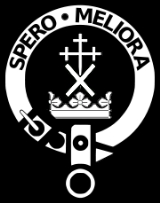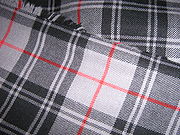
Clan Moffat
Encyclopedia
Origins of the clan
The Moffats are an ancient Borders family who were influential and powerful as far back as the time of Sir William Wallace. The ancestor of the Moffats most likely gave their name to the town of MoffatMoffat
Moffat is a former burgh and spa town in Dumfries and Galloway, Scotland, lying on the River Annan, with a population of around 2,500. The most notable building in the town is the Moffat House Hotel, designed by John Adam...
in Dumfriesshire
Dumfriesshire
Dumfriesshire or the County of Dumfries is a registration county of Scotland. The lieutenancy area of Dumfries has similar boundaries.Until 1975 it was a county. Its county town was Dumfries...
. The origin of the name itself is thought to be Norse. William de Mont Alto, progenitor of the Movats, married the youngest daughter of Andlaw, who came to Scotland from Norway during the tenth century. Over the years the name softened to Montealt, then Movat, through Movest, eventually settling at Moffat in its modern form. In the twelfth century the family was of sufficient importance to be designated in deeds and records as ‘de Moffet’, showing the family were considered to be principal lairds, or landowners.
In 1268, Nicholas de Moffet was Bishop of Glasgow, and the armorial bearings of the different branches of the family seemed to indicate a connection with the church. Robert the Bruce, as Lord of Annandale
Lord of Annandale
The Lord of Annandale was a sub-comital lordship in southern Scotland established by David I of Scotland by 1124 for his follower Robert de Brus...
, granted four charters of land in the Barony of Westerkirk to the Moffats in 1300. One of these was to Adam Moffat of Knock who was granted ‘the same Barony in Eskdale
Eskdale
-United Kingdom:*Eskdale, Cumbria, England*Eskdale, Dumfries and Galloway, Scotland*Eskdale, North Yorkshire, England*Eskdale , Cumberland, England, former constituency-United States:...
’. Both he and his brother fought at the Battle of Bannockburn
Battle of Bannockburn
The Battle of Bannockburn was a significant Scottish victory in the Wars of Scottish Independence...
in 1314, along with many Moffat clansmen. They remained the Lairds of Knock until 1609, when the land was sold to the Johnstones. They were also tenants of Midknock for six hundred years, until 1905. In 1336 the king of England granted a safe conduct to William de Moffet and others described as ‘coming as ambassadors from David de Brus’ – in fact, David II, son of Robert the Bruce. In 1337, Walter de Moffet, Archdeacon of Lothian
Archdeacon of Lothian
The Archdeacon of Lothian was the head of the Archdeaconry of Lothian, a sub-division of the Diocese of St Andrews. The position was one of the most important positions within the medieval Scottish church; because of his area's large population and high number of parish churches, the Archdeacon of...
, was appointed ambassador to France.
Wars of Scottish Independence
During the Wars of Scottish IndependenceWars of Scottish Independence
The Wars of Scottish Independence were a series of military campaigns fought between the independent Kingdom of Scotland and the Kingdom of England in the late 13th and early 14th centuries....
the Clan Moffat were supporters of King Robert the Bruce
Robert I of Scotland
Robert I , popularly known as Robert the Bruce , was King of Scots from March 25, 1306, until his death in 1329.His paternal ancestors were of Scoto-Norman heritage , and...
. As a result they received a charter from him for four charters of land in the barony of Westerkirk in the year 1300. The Clan were led by Adam Moffat of Knock at the Battle of Bannockburn
Battle of Bannockburn
The Battle of Bannockburn was a significant Scottish victory in the Wars of Scottish Independence...
in 1314. Their units consisted of heavy cavalry, nobles adorned in plate armour and well equipped picketmen. They were lowlanders and had the resources to equip their men.
16th century
The Clan Moffat had a long feud with the Clan JohnstoneClan Johnstone
-Origin of the name:Clan Johnstone is a Lowland Scottish clan. They were involved in many battles on the Scottish borders.Johnstone comes from "John's toun", not "John's stone" or "John's son." Historically, "Johnston" has been an alternate spelling of the surname...
who were another Scottish border clan who were raiders and reivers, and conducted long-running feuds with their neighbours. The feud accumulated in 1557 with murder of the Clan Moffat chief, Robert Moffat. The Clan Johnstone then went on to burn the church with the most important members of the Moffat family inside and slaughtered anyone who tried to escape. In one blow the powerful Clan Moffat was almost wiped out. Seventy years later all of the Moffats' lands were passed to the Johnstones due to the Moffats having massive debts.
The modern clan
From at least the mid sixteenth century the clan was without a chief, until 1983 when after many years of research, Francis Moffat was granted the undifferenced ArmsUndifferenced arms
Undifferenced arms are coats of arms which have no marks distinguishing the bearer by birth order or family position. In the Scottish and English heraldic traditions, these plain coats of arms are legal property transmitted from father to eldest male heir, and are used only by one person at any...
of Moffat of that Ilk, and recognised as the hereditary chief of the clan by Lord Lyon King of Arms
Lord Lyon King of Arms
The Lord Lyon King of Arms, the head of Lyon Court, is the most junior of the Great Officers of State in Scotland and is the Scottish official with responsibility for regulating heraldry in that country, issuing new grants of arms, and serving as the judge of the Court of the Lord Lyon, the oldest...
. In April 1992, the chiefship passed to his daughter, Jean Moffat of that Ilk.
Clan profile

Origin of the name
The surnameSurname
A surname is a name added to a given name and is part of a personal name. In many cases, a surname is a family name. Many dictionaries define "surname" as a synonym of "family name"...
Moffat/Moffatt is a habitational name of Gaelic
Goidelic languages
The Goidelic languages or Gaelic languages are one of the two branches of the Insular Celtic languages, the other consisting of the Brythonic languages. Goidelic languages historically formed a dialect continuum stretching from the south of Ireland through the Isle of Man to the north of Scotland...
origin, derived from Moffat
Moffat
Moffat is a former burgh and spa town in Dumfries and Galloway, Scotland, lying on the River Annan, with a population of around 2,500. The most notable building in the town is the Moffat House Hotel, designed by John Adam...
in Dumfriesshire
Dumfriesshire
Dumfriesshire or the County of Dumfries is a registration county of Scotland. The lieutenancy area of Dumfries has similar boundaries.Until 1975 it was a county. Its county town was Dumfries...
. This place-name translated as "the long plain" was derived from two elements: magh ("plain") and fada ("long"). The area of Moffat does not resemble a "long plain" at all, so it is thought that "Moffat" was the locals' attempt at saying "Mowat" as the Mowats, Moffats, and Montaltos all share a common progenator and at one time bore identical arms. (Major Francis Moffat of that Ilk, "The Moffats")
Clan chief, crest and motto
- Clan chief: Jean Moffat of that Ilk, Chief of the Name and Arms of Moffat.
- Clansman's Badge: A member of the Clan may wear a Badge consisting of the Crest from the Chief's Arms encircled by a strap and buckle http://www.baronage.co.uk/jag-ht/jag007.html. The Moffat Chief's arms has "a crest coronet and issuing there from a cross crosslet fitchee Sable surmounted of a saltire Argent".
- Clan motto: Spero meliora (translation from LatinLatinLatin is an Italic language originally spoken in Latium and Ancient Rome. It, along with most European languages, is a descendant of the ancient Proto-Indo-European language. Although it is considered a dead language, a number of scholars and members of the Christian clergy speak it fluently, and...
: I hope for better things, or I aspire to greater things).
Clan tartan
The Moffat family tartanTartan
Tartan is a pattern consisting of criss-crossed horizontal and vertical bands in multiple colours. Tartans originated in woven wool, but now they are made in many other materials. Tartan is particularly associated with Scotland. Scottish kilts almost always have tartan patterns...
is a very modern tartan, created by Major Francis Moffat of that Ilk, after being recognised as the chief of the clan in 1983. The tartan is heavily based upon the Clan Douglas
Clan Douglas
Clan Douglas is an ancient Scottish kindred from the Scottish Lowlands taking its name from Douglas, South Lanarkshire, and thence spreading through the Scottish Borderland, Angus, Lothian and beyond. The clan does not currently have a chief, therefore it is considered an armigerous clan.The...
tartan. According to Major Francis Moffat of that Ilk, in his book, "The Moffats," the colors he selected for the modern tartan (black, silver, and a very small amount of red) were taken from the most ancient arms coats associated with the Moffats, a black rampant lion on a silver field, with red teeth and claws.

